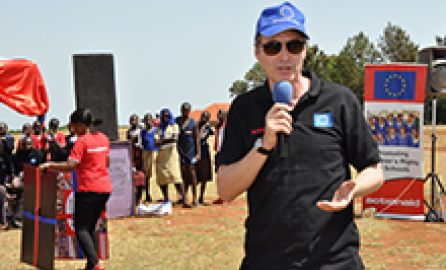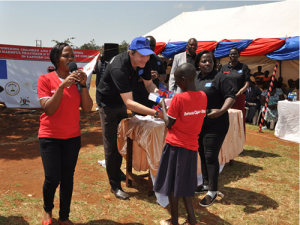Kristian Schmidt has been working as Ambassador and Head of the EU Delegation to Uganda for almost three years, following many issues including the 2016 elections. In this month’s Views from the Field he discusses the conflict context, and how Uganda has successfully handled an influx of 500,000 refugees from neighbouring countries.
Capacity4dev.eu (C4D): What is the conflict context in Uganda?
Kristian Schmidt (KS): There are quite a few dark shadows over the history of Uganda. I think most people have heard of Idi Amin, who ruled as dictator from 1971-79, causing genocide. But that wasn’t the end of Uganda’s violent path. From the late 1980s up until around 2006, the Lord’s Resistance Army (LRA) operated in northern Uganda. LRA was a fundamental Christian movement famous for abducting children, and it led a very violent rebellion displacing thousands of people.
There are also a number of other conflicts linked to resources, cattle rustling: a culture whereby nomadic herdsmen that consider cows their own personal property steal from their neighbours traditionally using spears, and more recently AK47s. And then there are conflicts linked to past kingdoms, traditional areas of loyalty that are being challenged by the nation state and the birth of the republic. There is really no shortage of conflict in Uganda’s past. Although the country remains peaceful today, there is certainly potential for past conflicts to reignite if they are not well managed.
Ambassador Schmidt at celebrations marking Day of the African Child
C4D: What are the key challenges that this presents for EU staff working in the delegation?
KS: Well, until a few years ago EU staff could not move freely around the country. We focus primarily on poverty eradication in regions where Uganda is still catching up. In the north, in Karamoja, we are trying to rebuild the livelihoods of youth who were deprived of their childhood when they were drafted as child soldiers. We operate in these areas trying to implement vocational training to replace years of lost schooling, and to find a future for these adolescents who have the choice of learning practical skills – like carpentry – or doing what they know how to do: carry a gun. It is a challenge to access these areas and demonstrate the dividend of peace by presenting alternatives to a violent past.
Karamoja is in fact a very dry rural area close to the border with Kenya. Therefore it is also a challenge to show people that it is possible to live off the traditional way of life, which is built on nomadic cattle keeping. To prove that within the context of climate change you can settle down, you don’t have to steal your neighbour’s cows, you can build a future in agriculture and become a sedentary farmer, leaving behind pastoralism. These are important challenges where Europe is invested for the long haul. It will take at least a decade to consolidate what is essentially a peaceful region now, but if left alone [it] could return to an area of violence.
C4D: How are the Delegation’s projects and programmes contributing to peace in Uganda, is this included in the Delegation’s strategic planning?
KS: It is, but this is not necessarily a conscious decision. I think you will find that the areas most affected by conflict in Uganda’s past, are of course now the areas where poverty is prevalent. We naturally concentrate on these areas that are at risk of falling back into conflict: the north, the northeast border with Kenya, and increasingly also some of the emerging slums in the capital city Kampala; where the risk is not so much poverty but marginalisation. This is something we have been looking at in the context of the new EU Trust Fund on Migration, to prevent political exclusion and religious radicalisation, a cocktail that could easily lead to terrorism and youth feeling marginalised. Uganda is the second youngest nation in Africa meaning the proportion of young people is enormous with very few job opportunities; which I worry about the most as a source of conflict for Uganda, not tomorrow, but in 5 years.
Another root cause that comes to mind is democracy. Democracy can be destabilising, as it can challenge the authority in power. 2016 saw a process of elections in Uganda and post-electoral violence is always a possible side-effect when pushing for democracy. Thus we can be hardliners on democracy and human rights, and I consider myself one of those, but we also have to be conscious of these side-effects. We shouldn’t expose ourselves to the easy criticism that you destabilised these countries – as happened in Libya, in Egypt, for all of the Arab spring – because you thought that it would lead to a Jeffersonian Democracy. I think we need to be more realistic and look at the long-term picture. Democracy takes time, and we should ensure that we don’t take one step forward and ten steps back.
C4D: You mentioned the border with Kenya. Do you work a lot with Delegations in neighbouring countries?
KS: Yes, we do, and we will do so increasingly in this border area. The risk is that we ignore that borders between nation states are completely artificial and issues can easily spill over from one country to another. I mentioned the Karamoja. Their people, Karimojong, are cattle-rustlers who move freely across borders, and of course that causes other problems of sovereignty. Therefore through the trust fund, we’re developing a programme with our colleagues in Kenya that will have a regional approach.
C4D: Why is conflict sensitivity important in Uganda?
KS: Well let me answer that with an example. In Europe we all worry about refugees and migrants. How it’s a big burden, which if not managed correctly could cause the disintegration of our societies. Well guess what: Uganda is hosting half a million refugees from the region. The country has in fact absorbed refugees from conflicts in South Sudan, Burundi, the Democratic Republic of the Congo, and historically also Tanzania. In many ways Uganda has become a host nation for refugees, even though they themselves were once refugees and with many people internally displaced within their own country.
The recent conflict in South Sudan caused a massive inflow of around 180,000 South Sudanese. They entered northern Uganda, an area which – as I explained – had already experienced its own internal conflict, and then suddenly it had to receive thousands of migrants.
They arrived in the Ugandan district of Adjumani (in the north) travelling in split ethnic groups as the conflict in South Sudan was between two ethnic groups: the Dinka and Nuer. When they arrived in these northern Ugandan settlements they wanted to live separately. However, the Ugandans said no. If you are here, part of the reason we are providing you with safety and a refugee status is that you will learn to live together. You will integrate into our schools, you will join our villages, where many of the Ugandans are internally displaced people (IDPs) so they will understand your situation. But you will not live in separate communities. You will go to the same schools and use the same health clinics.
That is the message that the Delegation is following and that is what the EU Trust Fund will be supporting in northern Uganda. To compensate Uganda for doing the right thing in terms of receiving refugees and teaching them to live together, with teachers from both South Sudan and Uganda. And then once the situation in South Sudan allows for it, moving back to South Sudan having learnt to live together in Uganda. It’s a model that we should be supporting.
C4D: Can this model be replicated in other countries and if so how?
KS: I visited these refugee settlements in Adjumani, and it is very impressive to see the hospitality of the local population. The Ugandans don’t just put them in camps, they are in settlements. What does that mean? It means a refugee is given a piece of land, they are not sitting idle in a tent in a refugee camp. They are actually given the opportunity to farm the land and maintain their skills. This also means that the women and children – because the majority of the refugees in that camp are women and children – learn to take care of themselves. Their husbands are either dead or fighting a war, but they are learning to build a future. So I would say this is a model that deserves our support.
It is also a model that depends on having available land and a tolerant host population. You will not find many countries where this is possible. In Kenya the reaction was, this is too much we are going to close the camps. But I think this notion of national borders is very much a fiction in many African countries. These are Sudanese brothers and sisters who happen to be on different sides of the border. If we support the natural solidarity that is there, what was an ethnic war can turn into a consolidation of peace with people learning to live together, even though they are on different sides. We should not be thinking about nation states when we consider these issues.
Ambassador Schmidt also commented on the importance of cultural understanding and consultation with local actors when working towards development goals. Find out more about the how the Delegation worked to overturn anti-homosexuality law in Uganda in the Voices & Views Bringing Intercultural Competence to Development.
Images copyright of the EU Delegation to Uganda.


Log in with your EU Login account to post or comment on the platform.